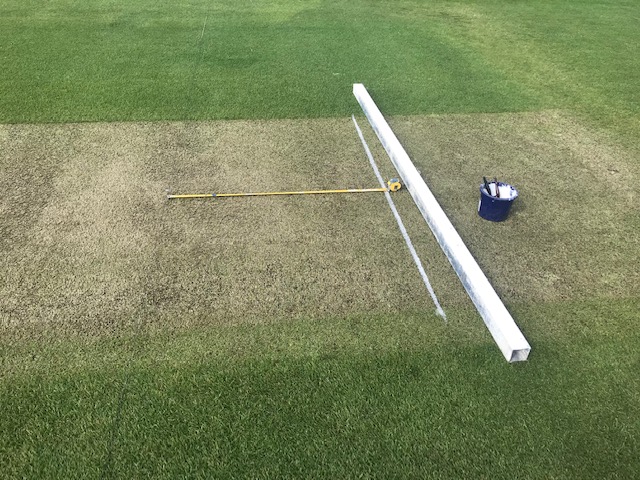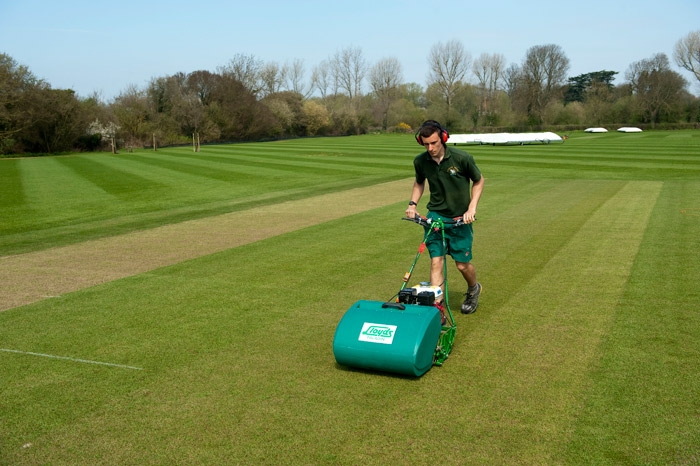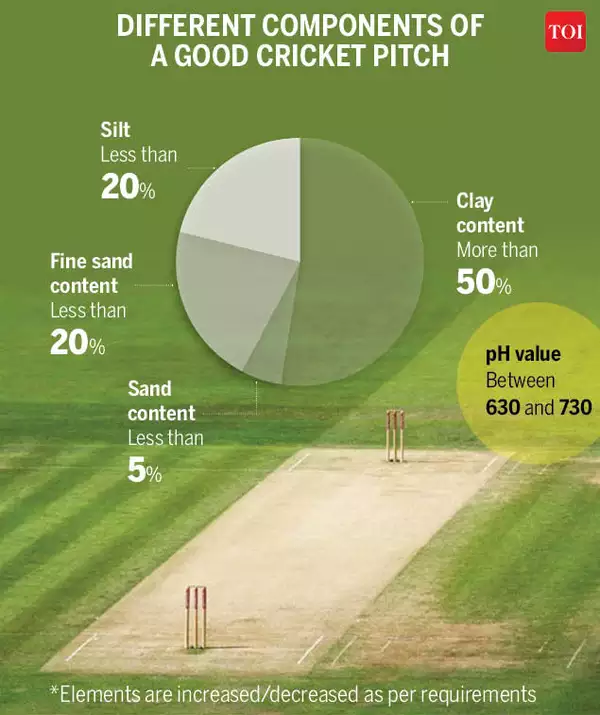Master the art of making a cricket pitch with our easy-to-follow guide. Elevate your cricketing experience starting from the ground up!
How to Make a Cricket Pitch: Step-by-Step Guide and Key Layers
Table of Contents
- 1 Types of Cricket Pitches
- 2 Materials Required
- 3 Dimensions of a cricket pitch
- 4 Step-by-Step Guide to Making a Cricket Pitch
- 4.1 Start to Reduce Height of Cut and Thin out The Canopy of Grass
- 4.2 Access the Moisture Level of the Soil Profile
- 4.3 Start Rolling the Pitch Area
- 4.4 Trim The Grass Evenly With A Scissor Lift
- 4.5 Seed the Pitch
- 4.6 Cover the Pitch
- 4.7 Install Rubber Matting (for artificial turf pitches)
- 4.8 Start Rolling Again
- 4.9 Let The Pitch Rest
- 4.10 Final Preparation (2/3 days Prior to The Game)
- 4.11 Final Cut and Mark Out
- 5 Who Decides What Kind Of Track To Play On?
- 6 The Science Of Soil And Pitch Preparation
- 7 3 Top Tips In Makin a Cricket Pitch
- 8 Cricket Pitch: A debatable subject
- 9 Conclusion
- 10 FAQs
- 10.1 What materials are needed to construct a cricket pitch?
- 10.2 How long does it take to make a cricket pitch?
- 10.3 How deep should a cricket pitch be dug into the ground?
- 10.4 Who has the final say in deciding the type of cricket pitch to be played on?
- 10.5 What are the different layers involved in making a cricket pitch?
- 10.6 What is the ideal location for setting up a cricket pitch?
- 10.7 Are there any maintenance tips for keeping a cricket pitch in top condition?
Types of Cricket Pitches
Cricket is a popular sport played by many countries, especially in the Indian subcontinent, Australia and England. It is a bat-and-ball game that requires precision, skill and strategy. A key element of this game is the cricket pitch – a strip of land upon which all the action takes place.
There are two types of cricket pitches: natural turf and artificial turf. Natural turf pitches are made from grass, while artificial turf pitches are made from synthetic materials. The process of making a cricket pitch is the same for both types, with slight differences in maintenance and durability.
Green Pitch
A green pitch is typically lush with grass and provides an excellent seam for bowlers. The extra grass aids the seam movement, making it more challenging for batsmen. However, it’s crucial to ensure the grass isn’t too long as it could hamper the ball’s bounce.
Dusty Pitch
A dusty pitch, as the name suggests, is dry and often found in subcontinental regions. It is ideal for spin bowling as it offers more turn and bounce for spinners. Care should be taken to avoid over-drying the pitch which can lead to uneven bounce and potentially hazardous conditions for batsmen.
Dead Pitch
A dead pitch is often flat and hard, with negligible movement for both seamers and spinners. It’s typically considered a batsman’s paradise due to the minimal assistance it provides to the bowlers. It’s essential to maintain a balance while preparing a dead pitch to ensure it doesn’t turn into a one-sided affair favoring the batsmen.
Materials Required
To make a cricket pitch, you will need the following materials:
- Soil (loam or mixture of clay, silt and sand)
- Grass seeds (for natural turf pitches)
- Rubber matting (for artificial turf pitches)
- Rollers
- Watering system

Dimensions of a cricket pitch
The dimensions of a cricket pitch are integral to the game. In accordance with the Marylebone Cricket Club (MCC), the global governing body for cricket, a standard cricket pitch should measure approximately 22 yards (20.12 m) in length and 10 feet (3.05 m) in width.
Step-by-Step Guide to Making a Cricket Pitch
Start to Reduce Height of Cut and Thin out The Canopy of Grass
To make a cricket pitch, you need to first prepare the ground. The soil needs to be levelled and compacted using a roller. Use a mower to reduce the height of cut from 10mm down to 5mm. This will help in thinning out the canopy of grass.
Access the Moisture Level of the Soil Profile
The moisture level is critical while making a cricket pitch. The soil should be damp and not too dry or wet. Use a shovel to dig up the ground and check the moisture levels by squeezing the soil in your hands. It should hold its shape without being sticky or breaking apart.
Start Rolling the Pitch Area
Once the moisture level is checked, start rolling the pitch area with a heavy roller. This will further compact the soil and create a firm base for the pitch.
Trim The Grass Evenly With A Scissor Lift
To ensure an even playing surface, use a scissor lift to trim the grass evenly. This will help in creating a smooth surface for the ball to bounce.
Seed the Pitch
If you are making a natural turf pitch, this is the step where you will need to seed the pitch. Use grass seeds and spread them evenly over the soil surface. Apply a thin layer of top-dressing (a mixture of sand, soil and peat moss) over the seeds to help them germinate.
Cover the Pitch
Covering the pitch with a roll of hessian cloth will help in retaining moisture and aid in germination. Keep the pitch well-watered to ensure proper growth of grass.
Install Rubber Matting (for artificial turf pitches)
For artificial turf pitches, you need to install rubber matting on top of the compacted soil. This layer helps in providing grip and bounce to the ball.
Start Rolling Again
After the rubber matting is installed, use a light roller to roll over it. This will ensure that any bumps or unevenness are smoothed out and provide a level playing surface.
Let The Pitch Rest
Once all these steps are completed, it’s essential to let the pitch rest for at least two weeks. During this time, the grass will germinate and grow to a suitable length for play.
Final Preparation (2/3 days Prior to The Game)
Before the game, mow the grass to a height of 7mm and roll it with a light roller. This will help in creating a firm surface for the ball to bounce.
Final Cut and Mark Out
On the day of the game, make a final cut on the grass to bring it down to 5mm in height. Use whitewash or paint to mark out the creases and popping crease on either end of the pitch.

Who Decides What Kind Of Track To Play On?
There is often debate around whether it’s fair for critics to reprimand India for preparing pitches that heavily favor their strengths, particularly when it’s expected for every host nation to possess a home-ground advantage. It’s indeed true that the home board has a say in this process and certain guidelines are in place, and the home team’s captain also has the opportunity to express his preferences.
As shared by Chauhan in a conversation with Timesofindia.com, “The responsibility of choosing the pitch lies with the curators. Their decision is based on the game’s format. While a captain can express his preference for a particular type of pitch to the home curator, it’s not within his power to enforce this request.” Chauhan continued, “The curators then convene to deliberate and follow BCCI guidelines to move the process along. Factors like evaporation, rolling, grass process, and soil composition are all key considerations in this decision.”
However, Chauhan, an MPCA representative, conceded that it was important to be cognizant of the home team’s strengths while making these decisions. He further elucidated, “As a curator, it’s crucial for me to be familiar with my team’s strong points. For instance, if you were to go to Australia, you would find pitches suitable for fast bowlers. In Test matches, the grass on these pitches would be around 8mm to 10mm. If they were preparing a pitch for an ODI, they would maintain a grass length of at least 6mm.
The Science Of Soil And Pitch Preparation
Making a cricket pitch is not just about leveling and compacting the soil and rolling it. There’s a lot more science involved in the process, with various factors taken into account to create a suitable playing surface for both teams.
The type of soil used plays a significant role in determining how the ball will behave on the pitch. Loam, which is a mixture of clay, silt and sand, is the most commonly used soil type for cricket pitches. However, the proportions of each component can vary depending on factors such as climate and desired pitch characteristics.
Similarly, the length and density of grass also affect the ball’s behavior. A longer grass length will provide more assistance to spinners, while a shorter length will help pace bowlers. The rolling process also plays a crucial role in creating a firm surface and removing any bumps or unevenness.

3 Top Tips In Makin a Cricket Pitch
- Understand the type of soil used and its characteristics, as this will greatly impact the behavior of the ball on the pitch.
- Pay attention to the moisture level of the soil profile and make necessary adjustments to ensure a suitable playing surface.
- Consider the strengths and weaknesses of both teams when deciding on pitch preparations, but also keep in mind any guidelines set by
Cricket Pitch: A debatable subject
The decision-making process for pitch preparations in cricket has always been a debatable topic. While the home team may have some influence in creating a suitable playing surface, it’s important to also consider the importance of fair play and providing an equal opportunity for both teams.
Understanding the science behind soil composition, grass length, and rolling techniques is crucial in creating a quality cricket pitch that can provide an enjoyable and competitive game. As a betting expert, it’s important to have knowledge of how cricket pitches are made so you can make informed decisions when placing bets on matches. With this step-by-step guide, you now have a better understanding of the process and can appreciate the work that goes into creating a perfect cricket pitch. So next time you watch a cricket match, take a moment to appreciate the efforts put into preparing the pitch for an exciting game.
Conclusion
In conclusion, making a cricket pitch is a complex process that requires knowledge and consideration of various factors. From soil composition to grass length and rolling techniques, every step plays an essential role in creating a suitable playing surface for the game of cricket. As a betting expert, understanding this process can help you make more informed decisions when placing bets on matches. Anв remember, the next time you sit down to watch a cricket match, take some time to appreciate the science and effort that goes into preparing the pitch.
FAQs
What materials are needed to construct a cricket pitch?
A cricket pitch is typically made with a mixture of clay, silt and sand known as loam, along with grass and other materials for marking out the creases.
How long does it take to make a cricket pitch?
The process of making a cricket pitch can take anywhere from 1-2 weeks, depending on the type of soil used and weather conditions.
How deep should a cricket pitch be dug into the ground?
A cricket pitch should be dug 10-12 inches deep into the ground to ensure a stable and firm surface. This also allows for proper drainage of water.
Who has the final say in deciding the type of cricket pitch to be played on?
The home board and curators have the final say in determining the type of cricket pitch to be used, with certain guidelines and considerations in place. The home team’s captain may express their preferences, but ultimately it is up to the curators to make the final decision.
What are the different layers involved in making a cricket pitch?
A cricket pitch consists of several layers, including the soil profile, clay layer, and grass layer. Each layer plays an important role in determining the behavior of the ball on the pitch. Overall, making a cricket pitch is a complex process that requires expertise and careful consideration to provide players with a fair and competitive playing surface.
What is the ideal location for setting up a cricket pitch?
A cricket pitch should be set up in an open area with good sunlight and proper drainage to ensure a suitable playing surface. Factors such as surrounding trees or buildings can also impact the quality of the pitch. So, it’s important to choose a location that meets these requirements for optimal playing conditions.
Are there any maintenance tips for keeping a cricket pitch in top condition?
Yes, regular maintenance is essential to keep a cricket pitch in top condition. This includes regular rolling and mowing to maintain the desired grass length, as well as ensuring proper drainage and soil moisture levels. Additionally, protective covers can be used during unfavorable weather conditions to prevent damage to the pitch. So, it’s important for ground staff to regularly monitor and maintain the pitch to provide the best possible playing surface.


















